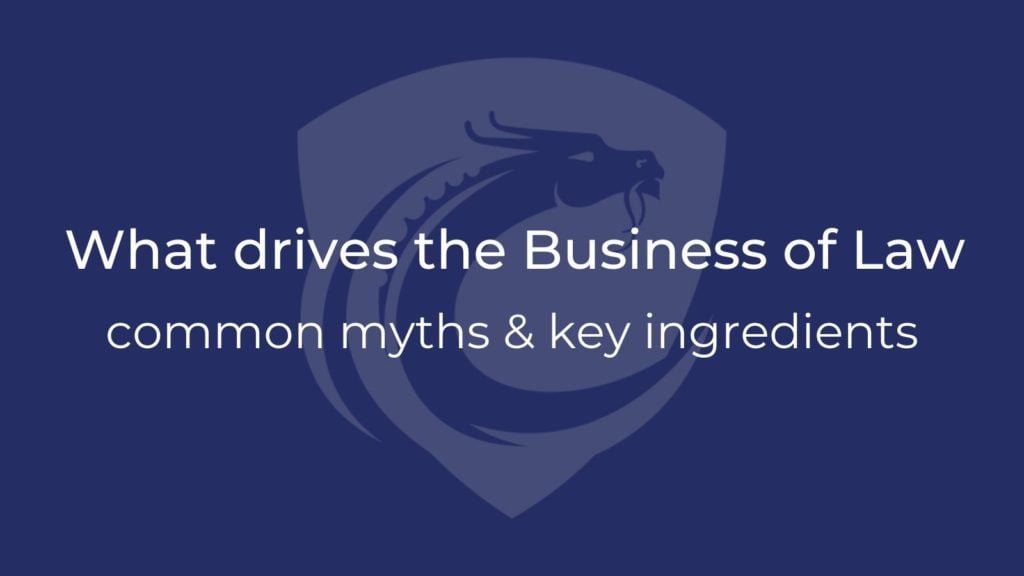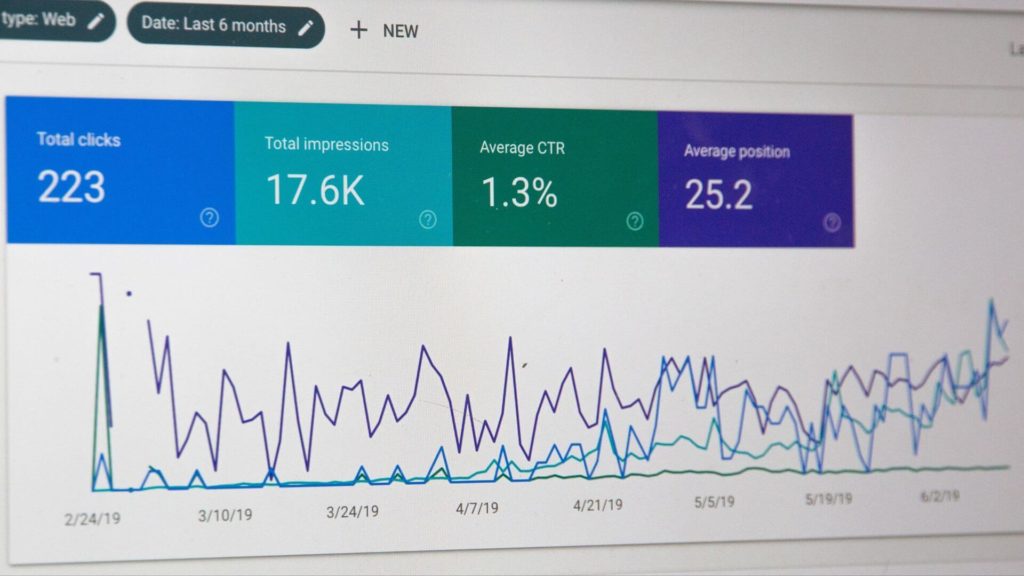The most common myths on the key drivers of law business
Have you ever tried searching “what drives the business of law” or “key drivers of law business” on Google? Mostly, you would get a few points on how “everyone needs to do business development,” that you need to “work harder” and even “raise your prices.” But such advice misses the mark and could harm your business.
Macro factors that drive the business of law involve purchasing power, the level of demand, and the changing nature of legal solutions. In your case, you need to observe what would help YOU increase your business and map down those drivers.
(please note how I said “your business” rather than “profitability.” In theory, you could raise your law firm profitability in the short term - e.g., by hiking up your hourly rates - and hurt your legal services business overall)
Makes sense? We are about to get practical and talk about what drives your law business. But firstly, let’s get clear on what is, in fact, the business of law.
I know - you have likely been in the legal services business for over a decade, at least. However, if your first association with the “business of law” is law firms, read this article first, then continue here.
(no worries, I’ll wait)
Done? Great, we’ve established that law business DOES NOT revolve around law firms nor legal services. That said, have we been asking the wrong question all along?
Do you prefer slides? Email editorial(at)cloutlegal(dot)com, and I will send you the deck.
Key drivers of law business - the wrong question
We can’t get the right answer if we keep asking the wrong questions. “Work harder,” “boost your utility rate,” and “raise your prices,” only make sense if you’ve wondered how can Biglaw-modeled law firms increase revenue.
And why is that the wrong question to ask?
For starters, that question will leave you blindsided. A strong bias toward short-term revenue growth could harm your business. As mentioned here, such bias could potentially get you to miss much more valuable opportunities to improve your legal service delivery model.
You need to stop thinking about legal fees, billable targets, and utility rates. These have nothing to do with any kind of business drivers.
Likewise, law firm headcount, leverage, luxurious office space, various award nominations, and mergers are nearly nothing but vanity indicators.
There are some exceptions here, and vanity indicators could assist with attracting clients.
I recently had a chat with William McLaughlin, (BD Manager at Zico Group) and Roy Ang (APAC Head of BD and Marketing at Withersworldwide). They mentioned that some clients would only indulge in a conversation with law firms that could boast specific rankings tier.
However, as both added, rankings have little to no actual value for their clients. Hence, law firm rankings and nominations are not something they would put as their primary focus, nor actively pursue.
Vanity indicators rarely answer the underlying question, which is…
What would make your target market come to you
What drives the business of law is your PRODUCT-MARKET FIT. That’s it, and there is nothing else.
Not sure what is a PMF?
“A value hypothesis is an attempt to articulate the fundamental assumption that underlies why a customer is likely to use your product. Identifying a compelling value hypothesis is what I call finding product-market fit.
A value hypothesis identifies the features you need to build, the audience that’s likely to care, and the business model required to entice a customer to buy your product. Companies often go through many iterations before they find product-market fit - if they ever do...” - Andy Rachleff
Photo by Artem Sapegin on Unsplash
In short, a product-market fit is a state where your offering satisfies strong market demand. It determines the stickiness of your offering, and can singlehandedly make or break your law business.
But how do you get to such a state in the first place? Is it sheer luck, or is there a method to the madness?
Well, that part belongs to the business development section. Contrary to what some would have you believe - business development does not equal marketing. Developing your business starts way before you ever engage your very first BD manager.
“First, you need to define and test your value hypothesis. And then only once proven do you move on to your growth hypothesis.
The value hypothesis defines the what, the who, and the how. What are you going to build, who is desperate for it, and what is the business model you are going to use to deliver it?”
Defining your offering for B2B
So how do you practically apply the above framework? For example, if you (plan to) sell legal solutions to corporate clients, your thought exercise may look like this:-
The “What”
Let’s start with your domain expertise. What are you selling today? Also, and even more importantly, what is the market buying, and how do you fit there?
(spoiler - it isn’t the hours)
For simplicity, let’s imagine “GDPR compliance legal solutions” is what you came up with. That could be a start in defining your product offering.
The “Who”
Here you should identify your primary or ideal target customer. In B2B, would you be selling to large corporates, early-stage tech startups, or SMEs?
(the above is just a single dimension that somewhat defines your target - you should be going much much deeper - to the point where you nail down specific attributes of people you would actively be selling to)
For example, “GDPR compliance legal solutions for digital marketing and lead generation SME agencies in France” is a specific offering to a defined target. From that point, you should try to sketch your likely contact prototype.
The deeper you go, the more you would learn. Hopefully, that translates to more successful sales.
Photo by Chris Liverani on Unsplash
The “How”
How will you deliver said GDPR solutions? Would you produce the services every time you receive a request, from scratch? Or would you have ready-made samples that you could reuse?
Then, how would your target customers request and access said legal solutions? Would they need to call or email you every time they need help? Or would you package those services in a self-serving model, and sell them as legal products?
This question will also dictate your fee arrangement.
If you craft legal solutions every time in a bespoke manner, you may likely be more inclined to use the billable hour (although you could do just fine with alternative legal fees).
Conversely, if you have nailed down your legal solution production to a single step, you are in a far better position to go with value pricing. This is how law firms without billable hours operate.
These firms have deep expertise and experience in the process. Hence, they can price their legal solutions against value with full confidence in their capacity to deliver well under the budget.
Finally, if you decide to wrap your legal solution as a product, you could be charging a price per usage volume, a monthly or annually recurring fee, or a combination of sorts. With legal products, you are in the territory of SaaS pricing, which makes sense to learn from their pricing practices.
The result
Going by our example, if you followed the whole process from the top, you could end up with something like…
The “Sentinel” - a legal product that keeps your digital marketing campaigns GDPR compliant via automated checklists and workflows. Monthly plans start from $19 for up to 10 campaigns; $49 for up to 30 campaigns; and $99 for more than 30 campaigns...
See what we did there together?
We “created” a software-based compliance legal product, made it easily available via a website, and attached a subscription pricing model. These so-called Compliance-as-a-Service apps (first dibs on the term) could be potentially built for any standardized compliance requirement.
Defining your offering for B2C
The above approach is quite the same if you are more inclined to work with consumers.
Starting with the “What” - you could, say, help people damaged by a massive retail producer (e.g., a faulty product) seek their indemnity.
The “Who” part will play a significant role since it would tell you how to reach this potentially massive group of people. Since you usually can’t reach everyone everywhere, you may want to get a bit more specific.
In addition to suffering damages due to a specific product, you would also specify their age group. The geography is likely more or less determined by the product reach, hence you would end up with something like:
“people of age 25-55, from <location>, damaged by product X”
Depending on the above profile, it may make more sense to target such people via online ads (e.g., via any of the social media platforms) rather than trying other means.
Ok, so after nailing the “What” and the “Who,” it is time to decide the “How.”
The “How” is the most critical aspect - the actual “make it or break it” ingredient. Here you are trying to determine how you would deliver your offering to your audience in a way that would make them love you.
You could, for instance, charge an upfront fee to all people who would like to use your services to get their indemnity. Additionally, you could require their data (ID, evidence of damage, etc.) in a traditional way.
Another option is not to charge an upfront fee and work only on a contingency basis. The so-called “no win no fee” model is a compelling proposition.
Additionally, you could use an underlying technology to collect all information that you may need in the process. Thus, your potential clients could start this whole process from the comfort of their homes.
A shameless plug - I am humbled that my team and I have participated in developing one such no-code platform, aptly named LEXolution FLOW.
The FLOW supports various use cases (e.g., legal products for Compliance as a Service model). Some law firms use it to reach people that may have the interest to join class-action lawsuits.
Photo by Anders Jildén on Unsplash
The key business of law driver
...is the product-market fit. That’s it, as simple as that. What drives the business of law is simply the product-market fit.
Heh “simply”… While it does sound simple, reaching product-market fit certainly isn’t. Some companies stumble upon it by chance, others never find it… Those that do are in a really great spot.
But what of other factors that we keep hearing about in the community? Are these also relevant for your law business?
Well, the answer is “depends” (yeah, I know - a lawyers’ favorite catch-all phrase). But it does - some factors may be relevant to your audience and offering, while others may not.
For example, I recently attended a web conference of a law firm alliance where one law firm partner described their experience setting up a China Desk.
In her final advice to other alliance members, she stressed that “having a Chinese team, as well as someone who can effectively manage it,” was paramount to setting up such a desk. If you can’t assemble one such team - don’t bother trying to penetrate the Chinese legal services market.
Effectively the partner was implying that a “Chinese team” was an essential aspect of their product-market fit for the Chinese legal services market.
But exceptional circumstances aside, let’s try to see here what factors may or may not be critical for a product-market fit:
Photo by Simon Abrams on Unsplash
Client relationships
So many law firm partners and pundits like to throw this one into the mix of key drivers of law business. But the truth is it is also very circumstantial. Relationships may matter in some segments of law services, and not in others.
For example, blue-chip b2b clients may prefer someone they know and trust over the new entrants. But even in this segment, other circumstances matter as well. Namely, in the “bet-the-farm” cases, clients are certainly more prone to go to their trusted advisors. Conversely, they could feel more “adventurous” in legal matters of smaller scope or relevance.
And what about retail? Well, again, you have to consider other circumstances too. Higher stake cases would always be driven by trust and prior relationships, while other factors could drive smaller-scope assignments.
Moreover, relationships may be more critical in certain macro conditions. As Roy Ang recently pointed in our online chat, he considers relationships most crucial than ever in these uncertain times. So much so, that he advises his law firm to make its priority to maintain close contact with its clients.
“It doesn’t matter how you will do it - just talk to your clients. If they prefer talking over a phone - pick up a phone. If they prefer to have a telco, do a telco. It is not so much about channels or technology here. Just think about what your clients prefer in any single case.
Especially in uncertain times, just focus on those clients that are the most critical to your law firm’s business…” - Roy Ang
Given that legal matters are often sensitive, I would agree that relationships matter, usually. However, if you build legal applications that aim to process small claims of the retail market (e.g., the model of flight compensation alps), relationships would be irrelevant.
(however, branding and excellent customer experience will be important here, but that’s another point entirely)
Photo by Luke Peters on Unsplash
Convenience of access
The Internet made nearly everything available at our fingertips, and it certainly shaped consumers’ expectations. That said, legal services aren’t known for being “accessible.” Access to justice has been an issue for decades, and some claim the situation is nowadays worse than ever.
Even corporate clients may struggle to access legal services. As Timothy Corcoran put it in our recent online chat:
“Many law firms wouldn’t be able to afford their own legal services. It is baffling then to understand why they feel their clients should be able to.
At least in highly commoditized legal requests, there is no reason why law firms wouldn’t create legal products and applications under a self-serving model.
These legal apps would make their legal services much more affordable and accessible. It would drive more business and more traffic their way - from their corporate clients - and it would undoubtedly do wonders for their brand...” - Timothy Corcoran
Apart from budgetary constraints, the convenience of access is pretty essential in repetitive high-volume cases. Think of any standardized compliance checklists that would have to be used pretty often by your target market. If you can think of any, you may have found an excellent opportunity to develop a legal application that would satisfy these requests (i.e., the Compliance as a Service model).
Conversely, with the “bet-the-farm” cases, the ease of access may be of secondary importance.
By way of example, this law firm has made it very convenient to access and use their know-how under the subscription fee model. I tried it and got the same results as if I visited a top-tier law firm.
(and all under two minutes)
Photo by Webaroo on Unsplash
Business development and marketing
This is kind of a gray area, and I guess it’s debatable. I don’t personally consider marketing activities as a critical business driver. Yes, marketing is essential to get eyeballs to your offering (no eyeballs - no business). From that standpoint, we can argue that marketing is one of the factors that drive clients your way.
However, marketing isn’t a primary factor. Indeed, once you get your audience’s attention, they would evaluate your offering. They would consider other factors (relevant to them) and decide if to turn to you based on those.
Your marketing campaign may have raised their attention, but the product-market fit would make them use your services repeatedly.
Furthermore, in my books, at least, business development means something different than marketing. To me, business development means developing your offering before you turn to the market.
(well, in fact... you need to turn to the market even while you develop your product-market fit, in what entrepreneurs call “customer development” - but that story is for another day)
In essence, business development means getting to the famed product-market fit. As such, it is critical to increasing your business.
However, you may understand “business development” as networking, referrals (as most still do). But I would argue those a) aren’t business development at all, and b) are just a subset of marketing (i.e., target only one stage of the funnel) and aren’t primary factors.
Law Firm rankings and nominations
(law firm rankings are a subset of marketing activities, so all said above about marketing also applies here. I just thought it makes sense mentioning it separately, as it is a frequently raised topic)
Your clients may not care about nominations. And most of BD managers and pundits seem to agree rankings bear zero value to clients.
Of course, some companies may have strict preferences about only working with firms of a particular tier. In that case, rankings would help you qualify to pitch before them.
However, once you are shortlisted, the product-market fit will ultimately decide if you will make it to the panel.
Photo by Denys Nevozhai on Unsplash
Your business model as a driver
Your law firm business model may play a role in getting new business from specific market segments. In some cases (usually the “bet-the-farm” kind), clients may not even mind the billable hour.
However, in other cases, you may only be able to open and serve new markets if you twist your business model.
Back to the example of delayed flights, this market wouldn’t exist without the innovative delivery model. Nobody will turn to lawyers to claim compensation if legal fees eat up the most of the (if not the entire) payment.
Legal tech as a driver of law business
Legal technology alone certainly doesn’t help. After all, why should I, as a client, care what tools do you use to solve my problem?
However, technology may be one of the key ingredients in your business model and, by extension, your product-market fit. If that is the case, then yes, legal tech might be one of your law business drivers.
But again, as you can see, it is pretty much circumstantial and depends on how you use said technology.
New offices, raising your rates, utility rates
I left a couple of myths for the end. The abovementioned factors are some examples that float online. Let’s see if they bear any relevance.
Opening a new location may be a channel to target particular markets, especially if we are talking about foreign markets where your firm had no presence before. However, the site and office itself aren’t the main reason why clients would come to you.
(you guessed it - the product-market fit is the main reason)
Some authors feel utility rates drive the business of law. I respectfully disagree. Why would clients ask about your utility rates? When was the last time they asked you about those?
Utility rates might reflect your organizational effectiveness and an underlying business model. But they aren’t the reason why clients choose you.
“Are you rates sufficiently high” is not something you would expect clients to ask you when deciding if to bring their business over. Yet, this was also something you can see online when you google about the law business drivers.
Photo by Markus Spiske on Unsplash
Other views from the legal community
(what is your view on what drives your business of law? Let me know - I am always curious to learn something new)
Markus Hartung, the managing partner of Berlin-based Chevalier, feels there is/will be a substantial increase in demand for legal services, even in times of uncertainty. Budget constraints will be more relevant than ever, so the pricing and your business models will play a good part in your product-market fit.
“The 2020 crisis will last. Legal service providers - both lawyers and non-lawyers” will be desperately needed, only as a part of the companies’ value chain…” - Markus Hartung
Lawyers will have to accept the Pareto principle (the 80%, or the “good enough” policy). Rarely who has time nor budget nowadays for perfectionism.
The LPOs and ALSPs (Axiom and the like) will drive innovation in the business of law going forward. When I asked “why,” Markus said:
“The Biglaw isn’t innovative enough. The Big 4 has a too rigid accountants’ mindset (although they are trying hard to break away from it). Alternative Legal Service Providers act like companies, and are attractive to upcoming generations…” - Markus Hartung
Olga V. Mack, the CEO of California-based Parley Pro, feels the business of law will follow broader technological trends. In her view, these trends redefine how companies operate (the so-called five “Ds”):
Digitization, Decentralization of information, Democratization of access, Diversity of thought, and Disruption.
Moreover, Olga feels that in-house legal teams have been one of the main engines of legal innovation:
“In-house legal departments have been at the forefront of innovation. While there are numerous explanations for that, five, in particular, stand out - in-house lawyers are rarely the show; the billable hour legacy is rare; there are very close ties to the business; the presence of other professionals; and constant reality checks…” - Olga V. Mack
Photo by Josh Timbas on Unsplash
Frequently Asked Questions
What is the business of law?
The Business of Law is to solve legal issues for a fee. Usually, law firms help clients through labor-intensive legal services. Nowadays, ALSPs leverage legaltech to create and serve new markets.
What are the key drivers of the business of law?
While some point to new desks, utility, and hourly rates, only the Product-Market Fit drives business. Legaltech, pricing models, etc. are contextual factors and are to be viewed in light of the PMF.
What are the threats to law firms?
The crisis and downscaling businesses negatively impact law firms’ bottom line. Moreover, there is increased competition from legal departments, the Big 4, and Alternative Legal Service Providers.
Ivan Rasic holds the Transnational Trade Law and Finance LLM, a program by Universidad de Deusto (Bilbao, ES), Universiteit van Tilburg (Tilburg, NL), and Goethe Universität (Frankfurt, DE). After his work in law firms and inhouse, he started a legal tech company.
Nowadays, Ivan leads STP Informationstechnologie GmbH's Sofia RnD center with project/development management, culture, strategy, and special project initiatives.
Ivan is an Ambassador at European Legal Tech Association (ELTA). He closely follows and writes on future of law, legal tech, ALSPs, and new ways of delivering legal services.
Ivan Rasic holds the Transnational Trade Law and Finance LLM, a program by Universidad de Deusto (Bilbao, ES), Universiteit van Tilburg (Tilburg, NL), and Goethe Universität (Frankfurt, DE). After his work in law firms and inhouse, he started a legal tech company.
Nowadays, Ivan leads STP Informationstechnologie GmbH's Sofia RnD center with project/development management, culture, strategy, and special project initiatives.
Ivan is an Ambassador at European Legal Tech Association (ELTA). He closely follows and writes on future of law, legal tech, ALSPs, and new ways of delivering legal services.














